The UAE's house price rises are slowing!
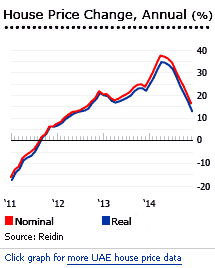 After the unsustainable growth surge of the last two years, Dubai’s housing market is slowing, and the same is true in Abu Dhabi.
After the unsustainable growth surge of the last two years, Dubai’s housing market is slowing, and the same is true in Abu Dhabi.
In December 2014, Dubai’s all-residential property price index (RPPI) was up by 16.48% (12.98% in real terms) y-o-y, according to Reidin.com. Dubai’s RPPI is calculated monthly and covers 7 cities, 8 main districts and 4 major projects. Abu Dhabi’s RPPI is also calculated monthly, and covers 7 cities and 4 main districts.
- Dubai’s apartment sale prices were up by 18.63% (15.06% in real terms) during the year to December 2014.
- Dubai´s villa sales prices rose by 8.41% (5.15% in real terms) over the same period.
Abu Dhabi, the UAE´s capital, also experienced an increase in its all-residential property price index by 7.96% (4.71% in real terms) during the year to end-December 2014.
- Abu Dhabi´s apartment sale prices increased by 7.05% (3.83% in real terms) y-o-y in December 2014.
- Abu Dhabi´s villa sales prices rose by 6.10% (2.90% in real terms) over the same period.
Sales prices in Dubai fell by 1% for apartments and 4% for villas quarter-on-quarter (q-o-q) in Q3 2014. Dubai now faces an “anticipated period of more measured and sustainable expansion”, say agents Cluttons.
The government’s cooling measures in the past few years have been effective, leading the IMF, which earlier warned UAE about its overheating real estate prices in Dubai, to back down from its concerns. According to IMF’s Middle East and Central Asia Department Head Masood Ahmed, price growth has noticeably moderated.
According to Asteco, the decline in sales prices was mainly due to the “continuous stream of new project launches and completions”. Despite the slight market correction, sentiment is still positive, as 27 new projects were successfully launched at Cityscape held in September 2014.
The good sales volumes achieved by Aldar on the Ansam and Al Hadeel projects at Al Raha Beach in Abu Dhabi show that there is still pent-up demand in the Investment Zones, according to Asteco.
During Q3 2014, Mamsha Al Saadiyat, located at the Saadiyat Island, was launched by TDIC at an average sales price of AED 2,000 (US$ 545) per sq. ft. The project has 400 luxury residential units ranging from one to four-bedroom apartments and townhouses.
Dubai´s total residential stock was around 377,000 units, Abu Dhabi´s around 243,000 units, at end-2014. In 2015, around 25,000 new housing units are expected to enter the Dubai market and 10,000 new housing units the Abu Dhabi market.
In 2014, there were 53,871 transactions in Dubai, according to Dubai Land Department (DLD)., worth AED 218 billion (US$ 59.4 billion). About 51% were sales, while 44% were mortgages.
The Federal Mortgage Cap, introduced in 2013, has slowed the pace of residential value appreciation in Abu Dhabi and Dubai. In addition, the Dubai Land Department recently doubled property registration fees from 2% to 4% to dampen property demand.
Foreigners now allowed to own property in Abu Dhabi on a freehold basis
Abu Dhabi, in contrast to Dubai, continues to take extra measures to make life easier for long-term foreign property investors, in an effort to buoy its local property market.
The government recently introduced a new regulation allowing foreigners to own property in Abu Dhabi on a freehold basis, in designated investment zones. Previously, foreign investors in the emirate were generally limited to leasehold arrangements with 99-year leases.
This follows Abu Dhabi´s previous market-boosting measures. In 2012, the government compelled public sector employees living outside Abu Dhabi to relocate within the emirate’s borders. Then in November 2013, the government cancelled a 5% cap on annual rent increases.
The great crash - a history lesson
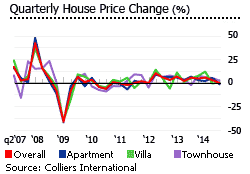
From 2002 to 2008, Dubai’s property prices almost quadrupled, and large-scale developments turned Dubai into one of the fastest growing cities in the world. Some of the biggest projects include Jumeirah Garden City (estimated cost: US$95 billion), Dubailand (US$64 billion), The Lagoons (US$25 billion), Palm Jumeirah (US$14 billion), and The World (US$14 billion).
After March 2006, a deluge of more foreign money boosted Dubai’s ambitions following the passage of the long-awaited foreign property ownership law. Europeans, including Russians, accounted for 20% of the buyers of all property categories. GCC, Arab nationals and UAE nationals made up 28%, Asians 40%, and Iranians 12%, according to figures from Global Realty Partners. The overall foreign ownership index of property kept by Colliers International soared 116% from Q1 2007 to Q3 2008.
Then the global credit crunch hit. Amlak and Tamweel, the UAE’s two largest home finance companies, stopped offering new loans. The two mortgage lenders accounted for more than 50% of all mortgages in the country.
Foreign investors suddenly disappeared at the end of 2008, as the global financial crisis hit the emirates. This caused transaction volumes to plummet. The overall foreign ownership index was 50% down by Q4 2010, from its peak in Q3 2008.
Almost half of all construction projects in the UAE, worth around AED1.1 trillion (US$582 billion), were either put on hold or cancelled, in response to falling demand and deteriorating market conditions. As the economy returned to growth, some of these halted construction projects, were resumed by end of 2011.
Signs of a property market recovery were visible in Dubai during Q4 2011 to Q1 2012, while Abu Dhabi followed suit. From January 2012 to end-2014 Dubai has experienced skyrocketing house prices, averaging around 21.49% annually.
Benchmark interest rate remains unchanged
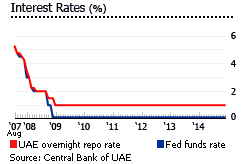
Mortgage interest rates in Dubai have, in the past, followed key US Fed rates, because of the peg to the US dollar. The dirham (AED) is pegged to the US dollar at AED3.67 = US$1. In 2008, when the Fed successively cut key rates, the UAE’s central bank was forced to track US monetary policy, causing inflation to hit a record high of 12.9%.
The Central Bank of the UAE set its first benchmark interest rate (overnight repurchase rate) at 4.75% in September 2007. The new repo rate gives the country slightly more flexibility in responding to changes in the US Fed funds rate.
After the Fed slashed its key rate to just 0.13% in December 2008, UAE´s benchmark rate was also reduced to a record low of 1% in January 2009. The key rate has been unchanged since then.
New mortgage rules

The Central Bank of UAE introduced a new set of mortgage regulations which came into effect a month after publication in the Official Gazette on November 2013. The purpose of the new regulations was to cool the property market.
New LTV rates imposed for UAE nationals and non UAE nationals are as follows:
UAE FEDERAL MORTGAGE CAPS (MAXIMUM LOAN-TO-VALUE-RATIO) |
|||
(Owner-occupier) |
Second home or investment property | Off-plan purchase | |
| NATIONALS
|
|||
| Property valued under AED5 million (US$1.36 million) |
80% | 65% | 50% |
| Property valued over AED5 million (US$1.36 million) |
70% | 65% | 50% |
| EXPATRIATES
|
|||
| Property valued under AED5 million (US$1.36 million) |
75% | 60% | 50% |
| Property valued over AED5 million (US$1.36 million) |
65% | 60% | 50% |
| Source: UAE Central Bank, Cluttons | |||
In 2013, the total aggregate amount of loans, advances, overdrafts and real estate mortgage loans rose by 1.2% to AED 708.3 billion (US$ 192.9 billion) from the previous year, according to the Central Bank of the UAE. Mortgage loans had risen from 2.7% of GDP in 2001 to 15.5% in 2010.
Perhaps surprisingly, banks and other mortgage lenders in the UAE are returning to the market and offering new mortgage products. Tamweel, one of the largest Islamic mortgage lenders, is back in the market, having stopped trading its mortgage shares in November 2008 due to the global credit crunch.
More fixed-rate mortgage products have been introduced. In addition, “fee free” products, which allow borrowers to switch to a new lender at a lower cost, have been offered starting during the last quarter of 2010.
New rent cap law in Dubai favours landlords
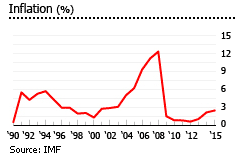
The new rent cap law, Dubai Decree No. 43/2013 (the “New Decree”), was introduced and came into effect in Dubai on December 18, 2013.
This new decree has the same cap of 20% as the previous rent cap (Decree No. 2 of 2011, known as the “the Old Rent Cap”). However, the new decree shifts the balance of power in favour of landlords, as they can now increase rent on lease renewal and as soon as rent for a property is 11% below the average market rental rate, lower than the 26% required under the Old Rent Cap.
The New Decree also makes clear that the rent cap also applies to special development areas and free zones, including the Dubai International Financial Centre (DIFC).
NEW RENTAL LAW |
|
| CURRENT RENTAL RATES | FOR 2009 |
| Equal to or 25% below the rental index | |
| 26% to 35% below the rental index | |
| 36% to 45% below the rental index | |
| 46% to 55% below the rental index | |
| More than 55% below the rental index | |
In 2006, at the peak of the property boom, the government introduced a rent cap of 15%, to control rent increases. Then in 2007, the rent cap was tightened to 7%. In 2008, the rent cap was again reduced to 5% in an effort to curb inflationary pressures.
In January 2009, Dubai’s Real Estate Regulating Agency (RERA) unveiled a new rental index to replace rent caps. Based on this law, the maximum percentage of rent increase is at around 20% for properties whose rents are more than 55% below the rental index.
Then in January 2011, RERA issued Decree No. 2, allowing adjustment of the rental index tables every four months, to keep rental values up-to-date, and requiring landlords and real estate leasing companies to register rental contracts on the newly-established e-registration portal system, the Ejari System, or face penalties for non-compliance. This enables the authorities to get an accurate picture of the market. In addition, RERA introduced a rental increase calculator to assist tenants and landlords compute their rent cap figures.
In Abu Dhabi, from November 10, 2013 the Abu Dhabi Executive Council cancelled the extension of the annual 5% rent increase rate, implying that they are actually removing the 5% rent cap. This is expected to boost competition among tenants, as well as causing some confusion to landlords, who are accustomed to increasing their rents by 5% every year.
Rents are softening
Residential rental rates softened for all unit types in Dubai during the third quarter of 2014:
- In Dubai, apartment rental rates fell by an average of almost 2% in Q3 2014 from the previous quarter, according to Asteco. However on an annual basis, rentals have surged by an average of 30.5% from the same period last year.
- In Abu Dhabi, apartment rental rates remained steady with a meagre 0.2% increase from the previous quarter in Q3 2014. Compared to a year earlier rents are up by around 5.1%.
In Dubai annual rents in Q3 2014 ranged from AED 44,000 (US$ 11,981) to AED 160,000 (US$ 43,567) for one-bedroom apartments, to from AED 100,000 (US$ 27,229) to AED 290,000 (US$ 78,965) for large three-bedroom apartments, according to Asteco.
In Abu Dhabi during the same period annual rents ranged from AED 40,000 (US$ 10,892) to AED 145,000 (US$ 39,483) for one-bedroom apartments, to from AED 60,000 (US$ 16,338) to AED 310,000 (US$ 84,411) for three-bedroom apartments.
Rents in specific developments:
- At the Discovery Gardens, annual rents for one-bedroom apartments for one-bedroom apartments range from AED 60,000 (US$ 16,338) to AED 72,000 (US$ 19,605); and two-bedroom apartments from AED 80,000 (US$ 21,784) to AED 90,000 (US$ 24,506).
- In International City, annual rents for studio apartments ranges from AED 33,000 (US$ 8,986) to AED 38,000 (US$ 10,347), while rents for one-bedroom apartments range from AED 44,000 (US$ 11,981) to AED 48,000 (US$ 13,070).
- At the Golf Gardens, located next to the Abu Dhabi Golf Club, annual rents were at AED 200,000 (US$ 54,459) and up for a three-bedroom villa.
- Annual rents for three-bedroom villas in MBZ City start at AED 100,000 (US$ 27,229).
Moderate rental yields in Dubai
Gross rental yields in Dubai are moderate, ranging from 5.55% up to around 6.64%, based on the Global Property Guide research as of September 2013. There was a slight decline in the average rental yields to 6.13% in 2013, from the 6.65% average recorded in 2012. Smaller apartments (60 – 90 sq. m.) have higher yields, averaging 6.58%, while larger apartments (120 – 200 sq. m.) have yields averaging around 5.69%.
Economic diversification will stimulate UAE’s growth in 2015
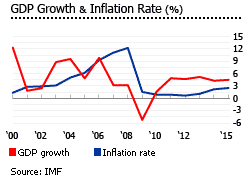
The UAE’s economy grew by about 4.8% y-o-y to more than AED1.54 trillion (US$ 42 billion) in 2014, despite the sharp decline of oil prices during the second half of 2014, according to UAE’s Minister of Economy Sultan Bin Saeed Al Mansoori.
This was higher than the expected 4.3% growth, although slower than 2013´s 5.2% GDP growth.
After an economic slump in 2009, the economy quickly recovered, expanding by 1.6% in 2010, 4.9% in 2011, and 4.7% in 2012.
The recent rise in economic growth was attributed by Minister Al Mansoori to the government’s efforts to diversify the economy. Non-oil sectors account for around 69% of the country’s GDP, while the remaining share is oil.
Driving the country’s economic diversification is the Abu Dhabi’s Economic Vision 2030, and Dubai’s Strategic Plan 2015, which aim to increase investment in industrial and export-oriented sectors. Meanwhile at the federal level, the UAE´s "2021 Vision" positions science and technology, research, and innovation at the centre of a knowledge-based and highly competitive economy by 2021. Non-oil GDP grew by around 5.6% in 2014, and growth is expected to remain in the 5% to 6% range from till 2016, according to the Abu Dhabi Commercial Bank (ADCB).
Due to the acceleration on non-oil diversification, the UAE is poised to grow at around 4.5% in 2015. The economy´s expected slowdown is due to the recent oil price slides, with some Gulf region countries already forecasting budget deficits in 2015.
“With this good performance, the general budget is expected to see a surplus of 9% of GDP, double the figure of 2012. Inflation rates have been estimated at between 2% and 3% in 2014, thanks to the flexibility of the UAE’s economy and the measures being taken by the government to curb price hikes,” according to Finance Minister Al Mansoori.
The UAE’s inflation rate rose to 3.1% in December 2014, the second highest level for five years, according to National Bureau of Statistics, propelled by increases in the education, furniture and household goods, and housing expenditure sectors.
Dubai’s overall inflation rate rose by 3.4% due to increasing rents, food prices and education costs, according to Dubai Statistics Centre. Abu Dhabi’s inflation rate rose to 3.3% during the same period, according to the Statistics Centre Abu Dhabi (SCAD).
Capital Economics and the National Bank of Abu Dhabi (NBAD) expect inflation of up to 3% in 2015. However inflation is unlikely to rise significantly higher than the forecast due to macro-economic measures that the government took after being warned by the IMF of a possible bubble or boom-bust cycle, according to NBAD’s senior economist, Alp Eke.